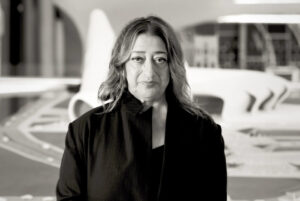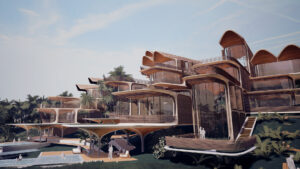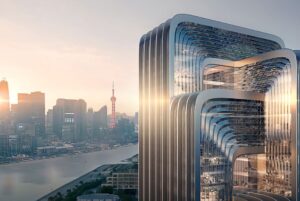
British – Iraqi architect Zaha Hadid takes her place on the podium of the iconic and the fearless
Zaha Hadid was a British-Iraqi architect. Renowned for her beautifully iconic built projects and their design. Recognized as a major figure in architecture in the late 20th and early 21st centuries, she disregarded the architectural status quo and protocols. Not only suggesting alternate possibilities in how we perceive a building should look, and how one might exist and engage with our built environments, she then presented, through mathematics and theoretical concepts what the alternate possibilities would look like and how to design and build them. Mystifying and fearless, incomprehensible, and unimagined, by mere mortals. (14) Her brand of mathematically inspired curving buildings. places her in a category yet to be named.
 Hadid is the designer of the London Olympics Aquatics Centre (2012), the Guangzhou opera house in the People’s Republic of China and built structures of beauty and innovative design in countries on potentially all four global quadrants.
Hadid is the designer of the London Olympics Aquatics Centre (2012), the Guangzhou opera house in the People’s Republic of China and built structures of beauty and innovative design in countries on potentially all four global quadrants.
Having left her homeland, Iraq, Hadid planted herself and her career in Britain and became a naturalized British citizen. She never married and had no children. In many ways, a perfect storm for a journey into the unknown arenas of theoretically untested, never-before attempted, architecture. Doing it all, in defiance of an industry dominated by males, Hadid made her presence known.
Early life and education
Zaha Muhammed Hadid was born October 31, 1950, in Baghdad, Iraq, to an upper-class Iraqi family. Her parents’ backgrounds were in politics and art. The road to success was already paved for Hadid, who attended boarding schools in both Switzerland and England in the ’60s.
Fascinated by architecture at an early age
A creative and calculative mind seemed a prevalent trait in Hadid’s intellect, as she spent her childhood experimenting with space, form, furniture, and fashion. Hadid recalled a time when her aunt was having her house built. The architect, a close friend of her father’s, would come by to show them models and drawings. “It triggered something. “Hadid said. (8) Additionally, during an interview, Hadid mentioned subsequent triggers of interest in architecture were credited to early childhood trips she took with her family to the ancient Sumerian cities in southern Iraq, observing the synchronous exchange and interaction with the landscape, waterways, buildings and people.
20th-century influences: Springboard to 21st-century innovations in architectural building and design
Her post-boarding school studies began at the American University in Beirut, Lebanon, where she received a bachelor’s degree in mathematics. In search of an alternative system to traditional architectural drawing. She moved to London to study at the Architectural Association in 1972, a major center of progressive architectural thought during the 1970s. Her former professor, Rem Koolhaas, described her at graduation as “a planet in her own orbit.”Elia Zenghelis described her as the most outstanding pupil he ever taught.
Hadid was greatly influenced by Suprematism and the Russian avant-garde. To compliment this train of thought, she adopted painting as a design tool and abstraction as an investigative principle, to revisit aborted and untested experiments of Modernism. Her hope was to bring new fields in building to the architectural stage.
A stuttered beginning
After graduation in 1977, she went to work for her former professor, Rem Koolhaas and Elia Zenghelis at the Office for Metropolitan Architecture, in Rotterdam, the Netherlands. Now a naturalized British citizen, Hadid opened her own architectural firm, Zaha Hadid Architects, in London in 1979/80. Not yet able to win her first UK commission, Hadid began her career teaching
architecture, beginning at AA. From there, she taught at notable Universities in the U. S. and Europe. Using her theoretically imagined and colorful paintings she made of her proposed buildings Hadid’s teaching career earned her a type of celebrity status in both the world of academia and in widely published architectural journals.
Hadid’s emergence onto the world stage
In 1983 Hadid gained international recognition with her competition-winning entry for The Peak, a leisure and recreational center in Hong Kong. The design of a “horizontal skyscraper” that moved at a diagonal down the hillside site. Her aesthetic was inspired by Abstract painter, Kazimir Malevich (1878-1935). Founder of the Suprematists abstract school of painting. Her aggressive
geometric designs, composed of fragmentation, instability, and movement would soon become a Hadid hallmark. The Peak was never realized as a built structure.
Architecture trademark/aesthetic: “I don’t make nice little buildings”
In 1988, Hadid was named among seven architects, to show her drawings and paintings in the Deconstructivism in Architecture” exhibition, curated by Philip Johnson and Mark Wigley at New York’s Museum of Modern Art. The exposure from this event greatly expanded her international reputation and fan base. The Tate in London followed, attracting press coverage of her work, which began to not only propel her name into the architectural universe but allowed people to associate a particular style of architecture with Hadid that would become her trademark aesthetic.
Triumph and disappointment; A blessing in disguise
 Hadid’s first major build and launchpad, was the Vitra fire station in Weil am Rhein, Germany (1991-1993) earning her international recognition. The fire station is now an events venue, as the fire company now occupies a more conventional facility.
Hadid’s first major build and launchpad, was the Vitra fire station in Weil am Rhein, Germany (1991-1993) earning her international recognition. The fire station is now an events venue, as the fire company now occupies a more conventional facility.
In 1994, selected by the jury as the winning entry to build the Opera house in Cardiff. The opera house was set to become a national landmark in Wales, but in the following year, the project’s funder, Britain’s National Lottery, withdrew its commitment to her designs, describing them as too Avantgarde. The snub by the British Lottery came after Hadid had won the competition twice.
The twofold disappointment almost pushed Hadid to abandon her career. Perhaps reminding herself of the architect’s role to keep her in the game, that being to serve by contributing to society. “Architecture, she, “must contribute to society’s progress and ultimately to our individual and collective wellbeing.” (12) And to her credit, she persevered, gaining support both on local
and international fronts from the architectural community and beyond. A blessing in disguise, since she now had garnished a solid core of admirers, increasing her popularity and reputation. This turn of events laid the groundwork for the realization of her era of built projects.
“Ultimately, architecture is all about wellbeing… Part of architecture’s job is to make people feel good in the spaces where we live, where we go to school or where we work.
Awards and accolades begin to flow
Her early run of built projects, beginning with the Contemporary Arts Centre in Cincinnati (1997-2000), earned her a place on the podium of “first women’, as the first woman to design a museum in the United States. As an add-on to this accomplishment, Hadid was presented the Royal Institute of British Architects Award in 2004 and the American Architecture Award the following year.
Following in hot pursuit, came the Evelyn Grace Academy, London (2008) -A Z-shaped school in Brixton, South London, that included a running track tunnelling right through the campus and out the other side. For this accomplishment, she was awarded the RIBA (Royal Institute of British Architects) Stirling Prize. Noting the hot favorite was the Olympic velodrome. London’s stamp of approval had finally rested on Hadid’s shoulders; an acknowledgement that had been long-awaited. Meanwhile, for Hadid, the commission wins kept coming.
Ensuing major projects included The Guangzhou Opera House project in China (2003–2010) In 2002. This was Hadid’s first international competition win, followed by the London Olympics aquatics Centre(2005-2012) the Broad Art Museum, Rome’s MAXXI Museum and many more of milestone proportions; the list being practically unexhaustive.
To note, a running list of her buildings still under construction at the time of her passing, included the Daxing International Airport in Beijing, and the Al Wakrah Stadium in Qatar, a venue for the 2022 FIFA World Cup.
Designs: She was not only an architect but a designer in every sense of the word
Her forerunning aesthetic lending to her use of geometric shapes to create dynamic, fluid structures, earned Hadid a reputation for producing groundbreaking and expensive, theoretical works across the globe.
Lending to her use of geometric shapes to create dynamic, fluid structures, she was described by, The Guardian as the “Queen of the curve”, saluting Hadid for leading the charge that “liberated architectural geometry, giving it a whole new expressive identity”.
Not feasible for construction, but a nod as sought-after works of art
Hadid was subsequently penned, the “paper architect”. A consideration given to her designs that were judged too avant-garde to move beyond the sketch phase. What some might have seen as a misstep, became Hadid’s next step. Her rendered designs of exquisitely detailed colored paintings were exhibit worthy.
These now works-of-art, were exhibited at MOMA, other major museums, and venues, around the planet, justifying her pen name, and her own name, that was becoming more familiar and commonplace. Hadid’s work was beginning to blur the lines of distinction between art and mere architectural renderings, a subliminal merger of the architectural and non-architectural community. These renderings of her designs on exhibition were not restricted to projects that were not deemed eligible to move to the build phase.
Renderings of Hadid’s works-of-art exhibited in museums, were comprised of both non-built and built.
“With each new project I always feel a real sense of discovery; a truly original and uplifting experience.”
One writer referenced Hadid’s built structures as gravity-defying, acknowledging a genuine degree of mystery behind Zaha and her work that was beyond what most perceive as artistic brainstorming. Hadid had her own signature protocols running in tandem with her personal design process. It was prevalent in the signature whoosh and in her created code of dots and swirls used in her evolving sketches.
A woman and Arab working in an English culture, created a greater contrast for Hadid from the start? “When I was growing up in Iraq ,… You cannot believe the enormous resistance I’ve faced just for being an Arab, and a woman on top of that. It is like a double-edged sword. “The moment my woman-ness is accepted, the Arab-ness seems to become a problem.”
To be accepted first, as an architect was her highest pursuit. A long struggle that was at the forefront of her professional wish list. However, in that struggle, Hadid developed a toughness that sustained her through those times of rejection and ambivalence. Admitting to her fondness for being an outsider, Hadid enjoyed “living on the edge”. “It’s made me tougher and more precise – and maybe this is reflected in my architecture. I still experience resistance, but I think this keeps you on the go.”
Zaha as a woman in a man’s world: A vanishing mindset
Regarding the challenges women face in navigating the professional world, Zaha attested to its certainty, although over the latter part of her life, the existing challenges and opposition were dispensed in less potent doses. In the 15 years prior to Hadid’s passing, she witnessed a tremendous shift towards leveling the playing field of fairness. From Hadid’s perch, she acknowledged an evolving degree of equity on the stage of architecture between males and females. She noted that “Half of architecture students are women, and you see respected, established female architects all the time.”, Hadid said.
Wisdom from on high: You can’t do it all
Speaking on the importance of teamwork to fulfill your vision, Hadid with few strings to pull and distract her focus, made a concerted decision and learned early on, that multi-tasking isn’t a solo act, and “you have to learn to trust other people to work on your vision”. Teamwork is very important to me, and that’s why things are manageable. I can’t take credit for my projects alone – many people in my office have contributed to them.
Commentary
 Not long after Zaha Hadid’s unexpected passing, Hadid’s dazzling early output of paintings and drawings – produced before her first building was completed in 1993 – was shown at the Sackler Gallery. The installation in Kensington Gardens’ old gunpowder store, transformed by Hadid herself, in 2013. The built structure, is complimented by a white canopy touting her signature curve merging downwards from 3 assigned points. A rare opportunity to view the singed corners of her sketchbooks presented to the public for the first time.
Not long after Zaha Hadid’s unexpected passing, Hadid’s dazzling early output of paintings and drawings – produced before her first building was completed in 1993 – was shown at the Sackler Gallery. The installation in Kensington Gardens’ old gunpowder store, transformed by Hadid herself, in 2013. The built structure, is complimented by a white canopy touting her signature curve merging downwards from 3 assigned points. A rare opportunity to view the singed corners of her sketchbooks presented to the public for the first time.
The exhibition created a never-before meetup between genius and the creative process of one said architect’s early years. revealing how an obscure pattern of coded script written in her notebooks of random dots, dashes, and swirls would gradually emerge as visually and intellectually engaging representations of built structures.
Although her work is acknowledged as phenomenal, were concerning the fate of her projects yet to be completed or started. Zaha no longer at the helm, some have begun to vanish with the passing of time, as there are none on her team capable of infusing unfinished projects with her design DNA. Possibly Zaha, has become her own artistic era.
On a brighter note, several of her buildings under construction at the time of her death, became completed projects. Included in the list are the Daxing International Airport in Beijing, which was completed on 30 June 2019 and the Al Wakrah Stadium in Qatar, a venue for the 2022 FIFA World Cup scheduled to take place in Qatar beginning November 21 to December 18, 2022. The stadium, broke ground in 2014; its construction was finished in 2019. It was the first of the 8 stadiums completed. A congratulatory, thumbs up, as this is the first World Cup ever to be held in the Arab world, and the second World Cup held entirely in Asia after the 2002 tournament in South Korea and Japan.
Zaha Hadid Foundation: Posthumous path for a trailblazer and pioneer
Perhaps, in response, the Zaha Hadid Foundation (ZHF), established by the Zaha Hadid herself, in 2013, whose purpose is to preserve and make publicly available the full range of Zaha’s extraordinary output, and more broadly to advance research, learning, and the enjoyment of related areas of modern architecture, art and design.
Of course, the foundation’s launch was placed on pause, due to the founder, Hadid’s, untimely death, but is Now fully underway to carry out her intended vision. The Foundation’s maiden voyage opened with the inaugural exhibition recently held at the Zaha Hadid Foundation. Entitled, Zaha Hadid:Reimagining London, opened to the public Wednesday, June, 8 through July 2, 2022. The
exhibition delved into the collections and archives of the Foundation. Sharing rare and unseen works, including personal sketchbooks from over forty years of practice. The personal library of her documented imaginations, reveals Hadid’s extreme and intricate approach to London’s reinvention.
Awards and accolades
Her Work wasn’t considered good enough and she stormed out of that office determined to “show them and show them she did
1. Winner of the coveted AA Diploma prize in 1977;
2. The first woman to receive the Pritzker prize in 2004; Designed to honor architects for their complete body of built work. founded in 1979 by Jay and Cindy Pritzker of Chicago. The original stated goal of the prize was to push architecture and architects into the public’s awareness and to on the premise that buildings have a real influence on people’s lives
3. The first woman to receive the Royal Gold Medal awarded by the Royal Institute of British Architects in 2015
4. Stirling prize in 2010 and 2011, UK’s most prestigious architectural award
5. Endowed by the Queen of England (2012) for her services to architecture
6. Presented posthumously, the statuette for the 2017 Brit Awards.
Her soaring structures left a mark on skylines and imaginations, and in the process reshaped architecture for the modern age.
Tangible representations of her complicated built projects often left engineers to push the limits of a material’s ability to accomplish her visual aesthetic. The Sackler Gallery, transformed by Hadid in 2013, is an example and testament to their determination in bringing the genius of her designs to fruition.
Some of Hadid’s projects: 1989-2012
Her built works from this period included a housing project for IBA Housing (1989–93) in Berlin, the Mind Zone exhibition space (1999) at the Millennium Dome in Greenwich, London, and the Land Formation.
One exhibition space (1997–1999) in Weil am Rhein. Hadid’s dynamic form of architecture explored her interest in creating interconnecting spaces.
• The Peak in Hong Kong (1983), Not built
• Kurfürstendamm 70 in Berlin (1986) Not built
• Cardiff Bay opera house in Wales (1994).Not built
• The Contemporary Arts Center of Cincinnati (1997-2003)Built
• London Olympics aquatics Centre (2005-2012) Built
• Guangzhou Opera House (2003–2010) Built First project in China, Hadid won an international competition.
• Evelyn Grace Academy, London (2008-2010) – Z-shaped school in Brixton, south London with a running track tunneling right through it and out the other side Won the Stirling Prize (2011). Given that the hot favorite was the Olympic velodrome. This was the year when Hadid finally felt she was being acknowledged in Britain.





